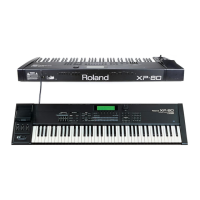146
Viewing only specific sequencer data
Phrase tracks or Patterns contain much sequencer data, and
so are difficult to view on the display. To effectively cope
with this, you can select the data types to appear on the dis-
play. By limiting the display to show just the type of MIDI
message you’re interested in, you’ll be able to find the MIDI
message more efficiently.
<Procedure>
❶ Make sure that the Microscope display (SEQ/Micro) is
up.
❷ Press [F6] (View) to call up the View Select display
(SEQ/Micro).
❸ Move the cursor to “Channel” and select the MIDI
channel whose data you wish to view.
To view sequencer data of all MIDI channels, set this para-
meter to ALL. To view the data of a specific MIDI channel,
specify that channel using numbers 1–16.
❹ Move the cursor to each type of data and set it ON
(when viewing that data) or OFF (when not viewing that
data). To view all sequencer data, press [F1] (All On).
When viewing only Note messages, press [F2] (Note).
When you wish to view only one specific type of data, move
the cursor to that data and press [F3].
✳ When the cursor is at “Channel” or “Note,” it is not
possible to press [F3].
❺ After you finish settings, press [EXIT] to return to the
Microscope display (SEQ/Micro).
Modifying sequencer data recorded in a
Phrase track/Pattern
You can modify the parameters of sequencer data recorded
in a Phase track or Pattern. However message type cannot be
changed, such as changing a Control Change message into a
Pitch Bend message.
✳ For details of sequencer data, refer to “Sequencer data
handled by Phrase tracks/Patterns” (p.144).
✳ Tune Request has no parameter so it cannot be modi-
fied.
<Procedure>
❶ Make sure that the Microscope display (SEQ/Micro) is
up.
❷ Select the Phrase track or Pattern whose data you want
to modify.
To select a Phrase track, press TRACK/PART [1]–[16].
To select a Pattern, press [PATTERN] to open the Pattern
Select window and specify the Pattern number.
❸ Press [u] or [d] to move “>” to the data to be modi-
fied.
❹ Press [l] or [r] to move the cursor to the parameter to
be modified, then specify the desired value.
✳ The note number (note name) of the Note or
Polyphonic Aftertouch data can be changed by press-
ing a key on the keyboard to specify the note number.
You can also press a numeric key while holding down
[SHIFT] to specify a note name (C–B) or an accidental
mark (#, b).
✳ To modify the OnV (On Velocity) or OfV (Off Velocity)
value of the Note data, you can also press a key on the
keyboard.
✳ When modifying System Exclusive messages, the pro-
cedure is slightly different. Follow the procedure
below:
...........................................................................................................
<Modifying System Exclusive messages>
<Procedure>
❶ Press [u] or [d] to move “>” to the System Exclusive
message to be modified.
❷ Press [r] to move the cursor to the data to be modi-
fied.
The Sys.Excl Edit display (SEQ/Micro) will appear.
By holding down [SHIFT] while you press [l], the cursor
can be moved right back to the beginning of data.
When moving the cursor to F7, press [r] while holding
down [SHIFT].
✳ As F0 cannot be changed, the cursor will not move to
this position. F7 also cannot be deleted.
❸ Modify the value.
To enter A–F, hold down “SHIFT” and press [0]–[5].
To insert a new value between F0:–:F7, move the cursor to
the desired location, and press [F1] (Insert). An initial value
of 00 will be inserted. Modify this to your desired value.
To delete a value, move the cursor to the location of the data
to be deleted, and press [F2] (Delete).
❹ When you finish modifying the message, press [F6]
(OK) to finalize the System Exclusive message value.
When the value is finalized, “COMPLETE” will appear just
for a moment before the Microscope display (SEQ/Micro)
returns.
To cancel System Exclusive message editing and return to
Microscope display (SEQ/Micro), press [EXIT]. If the cursor
is at the beginning of a System Exclusive message, you can
also cancel editing by pressing [l].
✳ If the message is a Roland Type IV System Exclusive
message, the XP-80 will automatically calculate the
check sum when you finalize values. If you don’t care
for this, press [F3] (Chk Sum) to open the window and
set “Auto Calculate Check Sum” OFF.
...........................................................................................................
Chapter 5. Editing a song
[SEQUENCER]➞[F4] (Micro)

